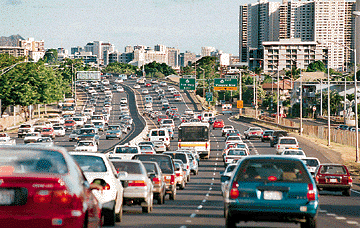
Traffic jams like these are a daily irritation for those who work
in downtown Honolulu but live in the suburbs.
Photo by Dennis Oda, Star-Bulletin


Traffic jams like these are a daily irritation for those who work
in downtown Honolulu but live in the suburbs.
Photo by Dennis Oda, Star-Bulletin
Two major traffic accidents clogged eastbound arteries into Honolulu, where they work, Maeda Timson heard. "I said, 'To hell with it.' We changed our clothes and we had breakfast and watched the sunrise," she said.
Timson, chairwoman of the Makakilo/Kapolei/Honokai Hale Neighborhood Board, and other neighborhood board leaders have ideas about what the mayor can do to help to fight gridlock.
Two major proposals came to the forefront, although neither had unanimous support: mass transit and shifting jobs to the planned second city of Kapolei.
Many believe in resurrecting the idea of a fixed rail-transit system for Oahu. The City Council shot down the $1 billion proposal by the Frank Fasi administration in the late 1980s.
Mayor Jeremy Harris says Oahu traffic is worse off because of the failure. Challenger Arnold Morgado believes the city would be bankrupt now if the project has been approved because an accompany tax increase proposal would not have brought in necessary revenues.
Willie Espero, chairman of the Ewa Neighborhood Board, said he sees no way around a fixed-rail transit system. "Mass transit is not just something we need to look at for only today, but 10 years, 20 years, 50 years from now," Espero said.
"Inevitable" is the way Pearl City Neighborhood Board Chairman Jerry Souza views a fixed-rail system on Oahu.
Many of the studies that the city needs are already in the vaults of Honolulu Hale, Souza said. The critical issue is financing, he said.
Richard Turbin, chairman of the Waialae Neighborhood Board, agreed. "We have to figure out a way to do it so it's not going to bankrupt the city or the state," he said.
"I don't think we can solve it any other way," said Kapolei's Timson.
Still, some believe the city should forget about mass transit and its heavy price tag.
Waipahu Neighborhood Board Chairwoman Annette Yamaguchi said she has ridden on rail-transit systems throughout the world.
Most, she said, are underused and therefore ineffective. "In Chicago, they have the most wonderful system, but I still sat two hours in traffic."
City and state government and private industry have been criticized for being slow in moving to Kapolei - hyped by former Gov. John Waihee as a means of shifting population and its related burdens away from Honolulu.
"There's so much vacant land out there," Yamaguchi said. "We're still looking at ways to fix going to Honolulu. What I believe we have to look at is ways to go to Kapolei."
"The greater portion of government could move out there," said Charlie Rodgers, Hawaii Kai Neighborhood Board chairman."You need to bring more services out there," Timson said. "We don't want to be a bedroom community."
Private companies and developers also need to be given incentives to move out toward Ewa, Kapolei and Waianae, said Timson and Rodgers.
Rodgers suggested tax incentives for private companies moving to Kapolei.
"In the long term, we need to bring jobs to the community," Souza said. "Everything is centralized in the Honolulu core and that is why we're facing this problem."
But not all feel a population shift is the solution.
Waialae's Turbin does not believe in the Kapolei solution. "You set up the regional centers and what do you do? You increase traffic. You'll have people traveling back and forth to conduct business."
Richard Poirier, chairman of the Mililani/Waipio/Melemanu Neighborhood Board, thinks such a plan would backfire.
Unless a large amount of jobs are available in a short period of time, "you increase the potential for more gridlock both ways."
Ken Newfield, chairman of the North Shore Neighborhood Board, believes in taking the slow-growth approach as a means to fight traffic.
"Stop approving development in rural communities before the traffic infrastructure is in place," Newfield said.
"They keep approving developments, be it the North Shore or Hawaii Kai. They kept developing and developing until the traffic was so bad they were forced to make the roads bigger. That's no way to plan."